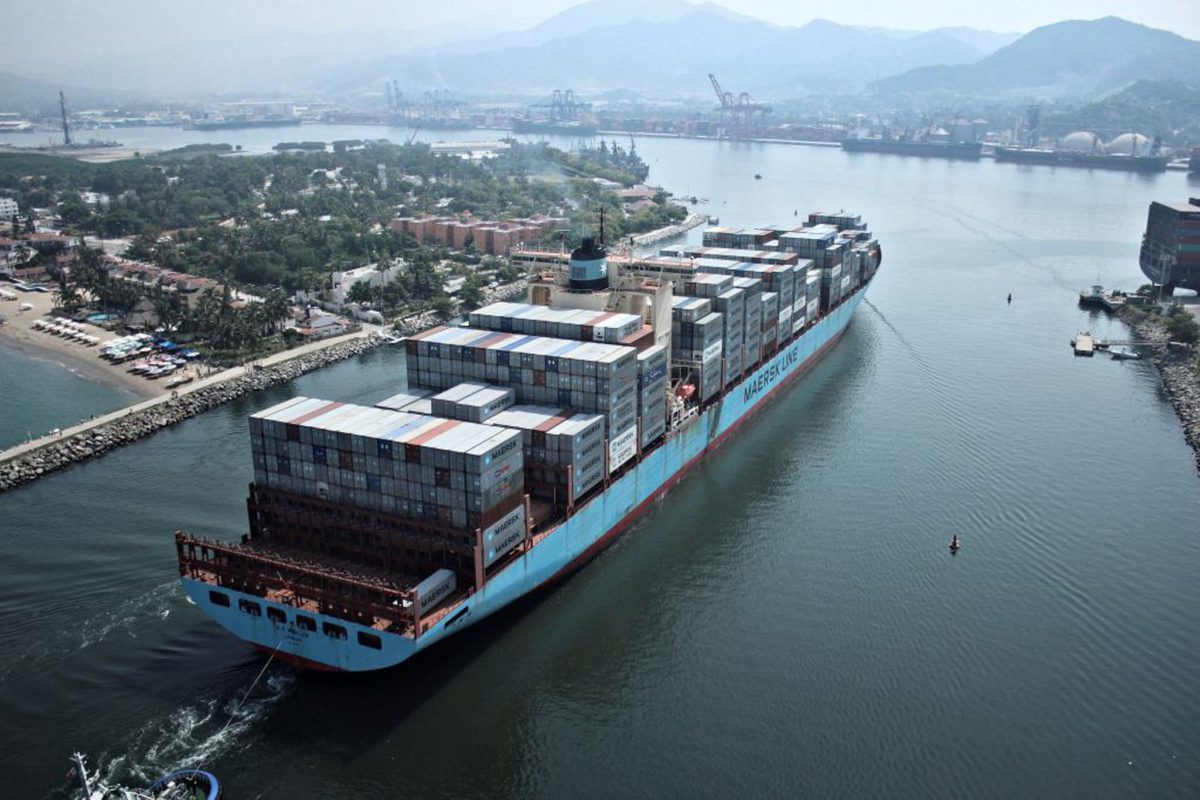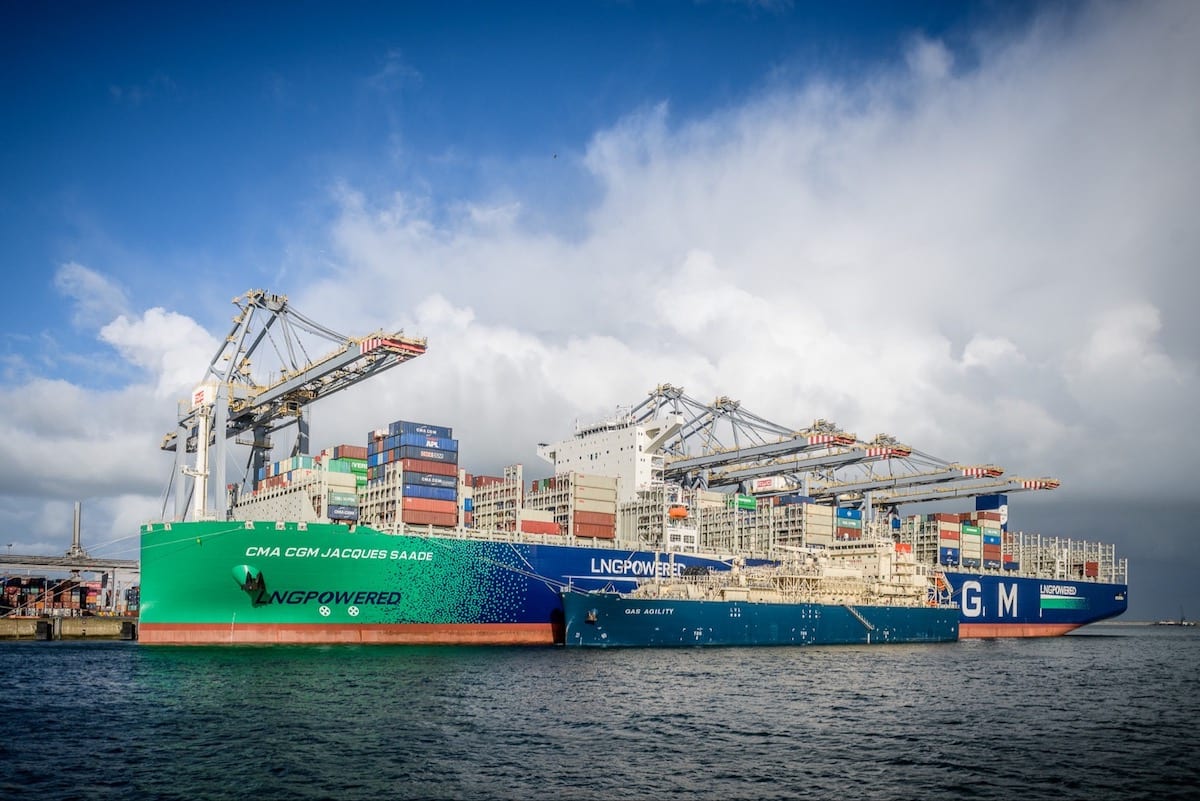Ninety percent of goods in global trade are carried by the ocean shipping industry each year. A new blockchain solution from IBM and Maersk will help manage and track the paper trail of tens of millions of shipping containers across the world by digitizing the supply chain process. (Photo credit: Maersk)
Technology giant IBM (NYSE: IBM) and Maersk, owner of the leading transport and logistics company Maersk Line, have announced a potentially groundbreaking collaboration to use “blockchain” technology to digitize transactions among the world’s vast and interconnected network of shippers, freight forwarders, ocean carriers, ports and customs authorities participating in the supply chain.
If widely adopted, the technology could transform the global, cross-border supply chain and save the industry billions of dollars, according to IBM and Maersk.
Ninety percent of goods in global trade are carried by the ocean shipping industry each year. As part of the collaboration, IBM and Maersk intend to work with a network of shippers, freight forwarders, ocean carriers, ports and customs authorities to build the new global trade digitization solution, which is expected to go into production later this year.
Blockchain technology, perhaps best known as the system behind the cryptocurrency Bitcoin, has the potential to vastly reduce the cost and complexity of trading to establish transparency among parties. The solution is designed to help reduce fraud and errors, reduce the time products spend in the transit and shipping process, improve inventory management and ultimately reduce waste and cost.
Maersk found in 2014 that just a simple shipment of refrigerated goods from East Africa to Europe can go through nearly 30 people and organizations, including more than 200 different interactions and communications among them. A blockchain system, used in this context, would allow for the real time exchange of original supply chain events and documents through a digital infrastructure, or data pipeline, that connects the participants in a supply chain ecosystem.
IBM and Maersk explain:
For example, goods from Schneider Electric were transported on a Maersk Line container vessel from the Port of Rotterdam to the Port of Newark in a pilot with the Customs Administration of the Netherlands under an EU research project. The U.S. Department of Homeland Security Science and Technology Directorate, and U.S. Customs and Border Protection are also participating in this pilot. Damco, Maersk’s supply chain solutions company, supported origin management activities of the shipment while utilizing the solution. The international shipment of flowers to Royal FloraHolland from Kenya, Mandarin oranges from California, and pineapples from Colombia were also used to validate the solution for shipments coming into the Port of Rotterdam.
“As a global integrator of container logistics with the ambition to digitize global trade, we are excited about this cooperation and its potential to bring substantial efficiency and productivity gains to global supply chains, while decreasing fraud and increasing security,” said Ibrahim Gokcen, chief digital officer, Maersk. “The projects we are doing with IBM aim at exploring a disruptive technology such as blockchain to solve real customer problems and create new innovative business models for the entire industry. We expect the solutions we are working on will not only reduce the cost of goods for consumers, but also make global trade more accessible to a much larger number of players from both emerging and developed countries.”
Improved Workflow and Real Time Visibility on the Status of Each Shipment
International trading parties require both improved workflow and better visibility. They need a faster, security rich and more efficient way to handle the documentation processes needed to move goods across international borders.
The costs associated with trade documentation processing and administration are estimated to be up to one-fifth the actual physical transportation costs. A single vessel can carry thousands of shipments, and on top of the costs to move the paperwork, the documentation to support it can be delayed, lost or misplaced, leading to further complications.
How it works:
- Blockchain, an immutable, security rich and transparent shared network, provides each participant end-to-end visibility based on their level of permission.
- Each participant in a supply chain ecosystem can view the progress of goods through the supply chain, understanding where a container is in transit. They can also see the status of customs documents, or view bills of lading and other data.
- Detailed visibility of the container’s progress through the supply chain is enhanced with the real time exchange of original supply chain events and documents.
- No one party can modify, delete or even append any record without the consensus from others on the network.
- This level of transparency helps reduce fraud and errors, reduce the time products spend in the transit and shipping process, improve inventory management and ultimately reduce waste and cost.
IBM and Maersk say a blockchain solution in shipping will promote sustainable transport by integrating shipping processes and partners, and establishing evaluation frameworks through increased transparency and trusted access.
An industry standard API for the centralized sharing of data and shipping information via the cloud was originally conceived by Frank Heijmann, head of trade relations, Customs Administration of the Netherlands, and David Hesketh, head of customs research and development, HM Revenue and Customs. In close cooperation with the European Commission services (Directorate-General Migration and Home Affairs and the Directorate-General for Taxation and Customs Union), it was further developed under the EU FP7 CORE demonstrator project.
“The Customs Administration of the Netherlands see the data pipeline as a tool supporting the balance between trade facilitation and enforcement, where information sharing in supply chains is optimized from a commercial perspective, and government authorities can re-use that information flow for supervision purposes,” said Heijmann. “It supports the needs of trade and governments in global supply chains, as it improves efficiency, compliance and security. The supply chain visibility serves all of those needs.”
For shippers, the planned solution can help reduce trade documentation and processing costs and help eliminate delays associated with errors in the physical movement of paperwork. It will also provide visibility of the container as it advances through the supply chain. For customs authorities, the solution is intended to give real time visibility, significantly improving the information available for risk analysis and targeting, which may eventually lead to increased safety and security as well as greater efficiency in border inspection clearance procedures.
“We believe that this new supply chain solution will be a transformative technology with the potential to completely disrupt and change the way global trade is done,” said Bridget van Kralingen, senior vice president, Industry Platforms, IBM. “Working closely with Maersk for years, we’ve long understood the challenges facing the supply chain and logistics industry and quickly recognized the opportunity for blockchain to potentially provide massive savings when used broadly across the ocean shipping industry ecosystem. Bringing together our collective expertise, we created a new model the industry will be able to use to help improve the transparency and efficiency of delivering goods around the globe.”
The solution developed by Maersk and IBM is based on the open source Linux Foundation’s open source Hyperledger Fabric. The solution is expected to be widely available to support multiple parties across the ocean shipping industry ecosystem later this year.
Unlock Exclusive Insights Today!
Join the gCaptain Club for curated content, insider opinions, and vibrant community discussions.

 Join The Club
Join The Club













